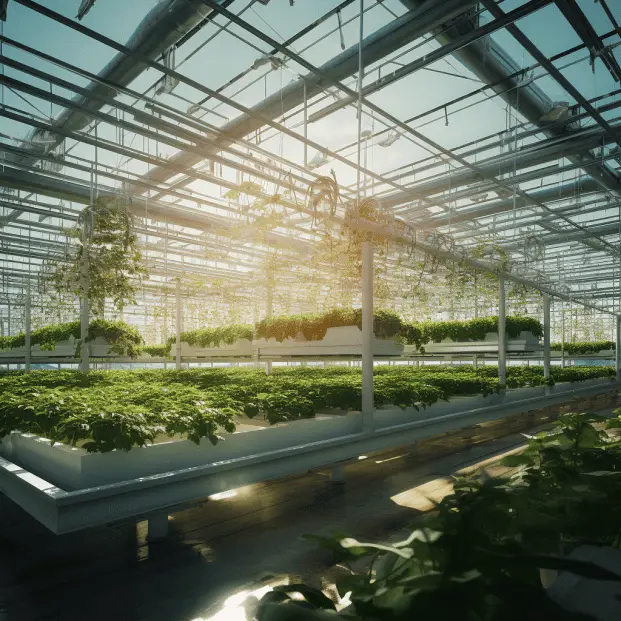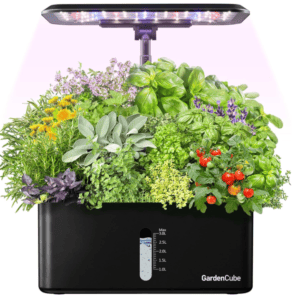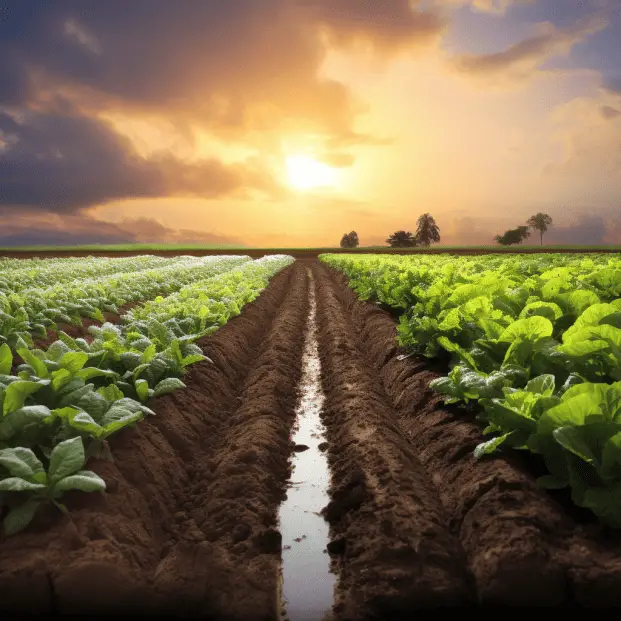
According to hydroponics expert Mark Wilson, “Hydroponics offers faster growth, higher yields, and healthier plants compared to soil gardening.”
As a soilless method of cultivation, hydroponics gives you precise control over nutrients, light, water and other inputs.
Discover the many benefits hydroponics provides for home and commercial growers alike.
From reduced disease to simplified maintenance, hydroponic systems maximize productivity in limited spaces.
Whether curious about this futuristic farming method or ready to install your first system,
Read on to understand why hydroponics is the future of efficient, sustainable food production.
KEY TAKEAWAY
What are the benefits of hydroponics?
Hydroponics (1) offers remarkable advantages, including higher crop yields, water efficiency, and the ability to grow in diverse environments.
It’s a sustainable and innovative approach to agriculture, providing solutions to food production challenges.
Benefits of Hydroponics
Hydroponics is changing the face of modern agriculture.
By growing plants in nutrient solutions rather than soil, hydroponics unlocks new possibilities for maximizing crops, space, and resources.
From patios to greenhouses, hydroponics can expand food production.
But what exactly are the benefits driving this hydroponic revolution?
The precise control and optimization of hydroponics has ripple effects encompassing water conservation, yields, quality, labor, and more.
Read on to understand the power of soilless agriculture.
Needs No Soil
One of the biggest advantages of hydroponics is that it eliminates the need for soil.
Hydroponic plants grow in nutrient-rich water solutions instead of dirt.
Their roots absorb everything they need straight from the water.
This makes hydroponics possible even in places without good quality soil.
You can set up a hydroponic system on a rooftop, patio, or right inside your home.
Hydroponic farms grow crops indoors in warehouses and greenhouses built on concrete.
No soil required!
By avoiding soil, hydroponics dodges issues like poor drainage, nutrient deficiencies, erosion, and compacted roots.
The specially formulated nutrient solutions provide ideal conditions for growth.
Plants get consistent water and nutrients without dealing with changing soil conditions.
Water Conservation
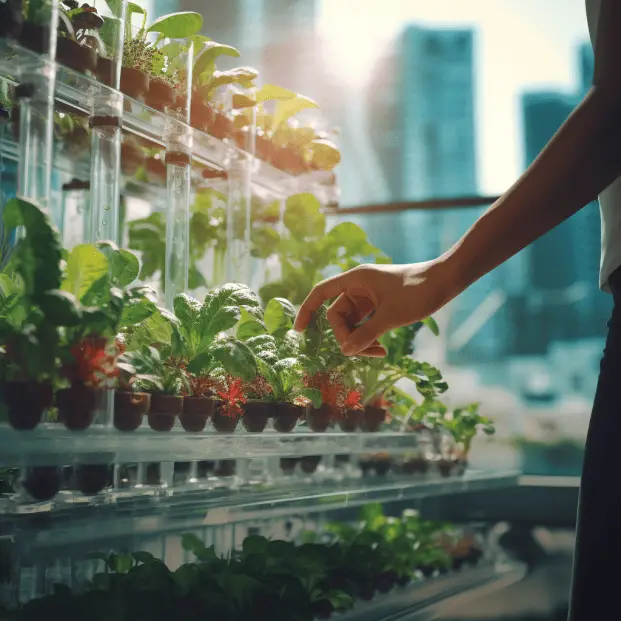
Hydroponics uses a closed-loop recirculating system to conserve water.
The nutrient solutions that bathe the roots are collected, replenished, and reused.
Little waste occurs compared to water runoff from field irrigation.
NASA studies found hydroponics uses up to 90% less water than conventional soil farming. (2)
A hydroponic farm can save over 100,000 gallons per acre compared to outdoor fields! This is crucial in drought-prone regions.
Recirculating systems allow hydroponic farmers to precisely monitor the solutions.
Any water drained off can be sterilized and returned to the tanks.
Natural rainfall can even be collected and utilized.
Facilitates a Micro-Climate
With hydroponics, the plant’s entire environment is under the farmer’s control.
Indoor hydroponic spaces allow customization of conditions like temperature, humidity, light duration, and air circulation.
This micro-climate can be tailored to each crop’s specific needs.
For example, lettuce thrives around 75°F while tomatoes fruit best at 85°F daytime temps.
Light-emitting diode (LED) grow lights are programmed for ideal intensities and color spectrums.
Outdoors, changing weather causes stress and slowdowns.
But hydroponic plants grow steadily in optimized micro-climates for maximum production year-round.
Predictability and Seasonality
While outdoor farming depends on seasonal changes, hydroponics gives total control over growing conditions.
Plants get precisely calibrated light, warmth, moisture, and nutrients every single day.
This predictability results in rapid, consistent growth and high yields.
Hydroponic farmers can schedule harvests more reliably since crops are not at the whim of variable weather.
They can produce popular veggies year-round, not just seasonally.
Some hydroponic greenhouses rotate different crops on staggered schedules to maximize production.
Others focus on quick turnover of leafy greens and herbs for a steady supply.
Either way, hydroponics beats seasonality challenges.
Faster Crop Growth
With optimally balanced nutrient solutions delivered right to the roots, hydroponic plants grow up to 50% faster than soil-grown plants.
Their precisely controlled environment removes limits on normal growth.
Constant hydration and nutrients eliminate the vegetation and fruiting delays plants experience when waiting for soil nutrients.
Hydroponic plant growth surges ahead without these slowdowns.
With hydroponics, farmers can go from seed to harvest in nearly half the time.
Many hydroponic lettuces and greens are ready for cutting just 30-45 days from seeding.
This supercharged growth enables more production cycles per year.
Maximizes Space
Hydroponic systems take advantage of vertical space to multiply production in limited areas.
Designs like vertically stacked grow towers, rotating barrels, and trailing vines allow dense planting with excellent light exposure.
In the same greenhouse or building footprint, a hydroponic farm can yield many times more produce than soil farming.
For example, vertical lettuce towers produce 20-25 heads per square foot versus 2-3 heads with conventional methods.
Urban hydroponic operations make use of compact indoor spaces like warehouses, shipping containers, and rooftops.
Limited land is no longer a dealbreaker for agriculture.
Higher Yields
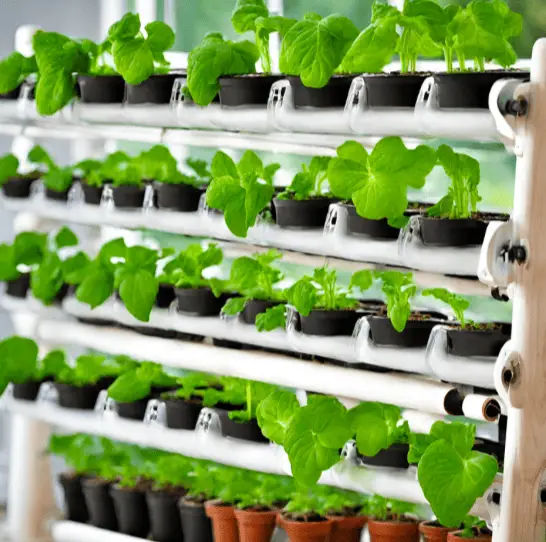
The controlled environment, faster growth rates, and maximized space result in phenomenal yields from hydroponic farming.
Studies show hydroponically grown vegetables and herbs yield 25-50% more per year than soil farming.
By avoiding issues like nutrient deficiencies, pests, disease, and environmental stress, crops can reach their full genetic potential.
The consistent conditions allow them to divert more energy into fruit and vegetable production.
Larger fruiting vegetables like tomatoes, cucumbers, and peppers thrive with the continual moisture and nutrition of hydroponics.
Their yields excel in hydroponic greenhouses.
Labor Efficiency
While hydroponic systems require monitoring and maintenance, they eliminate much of the grueling labor of traditional farming.
There is no weeding, tilling, digging, or heavy equipment operation.
Indoor hydroponic environments are cleaner, climate-controlled, and more ergonomic than working outdoors or in a greenhouse.
Automated systems further reduce hands-on labor.
Overall, hydroponic crop production takes fewer person-hours per pound of produce compared to conventional methods.
The difference is even more substantial for leafy greens and herbs with multiple harvests per plant.
Shortens the Supply Chain
Locating hydroponic farms right in cities and suburbs means produce can go from harvest to consumer in hours or days rather than weeks.
This appeals to shoppers wanting the freshest local food.
Urban hydroponic growers can sell directly to restaurants, grocery stores, and farmers markets nearby.
Some even have on-site retail shops.
This eliminates complex distribution chains and transport.
Customers appreciate knowing exactly where their produce was grown and seeing growing operations firsthand.
The local connection creates goodwill and brand loyalty.
Produces High-Quality Food
The ability to meticulously control growing conditions results in exceptional produce quality from hydroponic farming.
Plants get optimal light, constant nutrients, and pure water without pathogens.
There is no concern over nutrient deficiencies, soil-borne diseases, pests, mold, mildew, or contaminants.
Hydroponic produce is nutritionally superior and lasts longer after harvest.
Consumers notice the difference in visually perfect and delicious hydroponic fruits and vegetables.
Once people try hydroponic produce, they gain a new appreciation for its quality advantages.
Hydroponic Farming vs. Traditional Agriculture
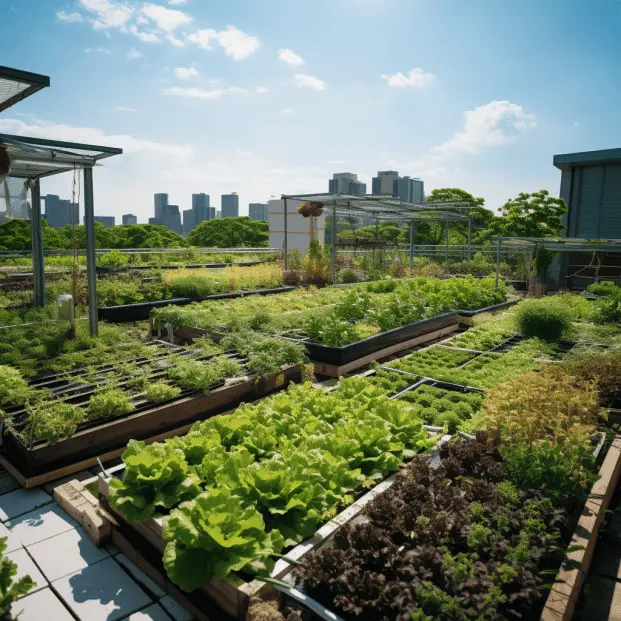
Hydroponic farming and traditional agriculture each have their advantages and disadvantages.
Traditionally, agriculture has relied on arable land and soil to grow crops.
Soil provides nutrients and structure for plant roots to grow strong.
However, arable land is limited and susceptibility to issues like erosion, drought, flooding and soil-borne diseases can threaten crop yields.
Hydroponic farming addresses these issues by growing plants without soil.
Instead, roots are supplied nutrients directly from water and solutions.
This allows year-round cultivation in controlled environments like greenhouses, independent of weather changes.
Hydroponics uses space more efficiently, growing vertically or on rooftops.
However, higher energy needs and operating costs mean hydroponics is not feasible for all farmers.
Both methods play an important role in sustainably meeting global food demand, with advantages…
…depending on the location, resources and goals of the operation.
Disadvantages of Hydroponic Farming
Hydroponics grows plants in nutrient solutions without soil.
While there are benefits like higher yields and vertical farming, hydroponics has disadvantages too:
Disadvantages:
- Energy intensive – significant electricity for lighting, climate control
- High upfront investment in equipment and infrastructure
- Demands technical skill to monitor nutrients and environments
- Pests and diseases spread rapidly in indoor setting
- Equipment failure can ruin entire crop
- Lacks beneficial microbes found in soil
- Plants suffer quickly if nutrients or power disrupted
- Ongoing operation costs are higher
- Steep learning curve to master formulas and controls
- Less accessible for small-scale growers due to high startup costs
While hydroponics maximizes space and yields, it requires more inputs than traditional farming.
Advancements to lower costs could make hydroponics more feasible for small growers.
But for now, many farmers rely on traditional agriculture with its lower startup costs and natural growing environment.
Both methods play roles in meeting produce demand sustainably.
Conventional agriculture uses soil as a time-tested medium balanced with high-yield hydroponic systems.
Types of Hydroponic Systems
There are several types of hydroponic systems for growing plants without soil.
Each supplies nutrient-rich water and oxygen to plant roots without the need for soil.
Nutrient Film Technique (NFT):
- Plants sit in enclosed troughs with a gentle stream of water constantly re-circulating past the roots.
- Uses less water and provides efficient nutrient delivery.
- Best for small plants like leafy greens and herbs.
Deep Water Culture (DWC):
- Plants suspended above oxygenated nutrient reservoirs.
- Roots grow down into the solution but are not submerged.
- Air pumps oxygenate the water.
- Yields very productive vegetables like tomatoes.
Floating Raft:
- Plants in clay balls or rocks float on rafts in nutrient-filled tanks.
- Shared reservoir enables efficient water usage.
- Rotating crops allows continuous harvests.
- Great for greens, herbs and flowers.
Bag Ponics:
- Plants grow in fabric bags filled with clay pellets or perlite.
- Bags hang and flood/drain with nutrient solution.
- Roots stay moist but not saturated.
- Works well for fruits, veggies and flowers.
- Easy to harvest by removing bags.
In summary, different hydroponic systems suit different spaces, budgets and crops.
All provide the essential water, nutrients and oxygen to let plants thrive efficiently without soil.
Choosing the right method is key to outstanding results.
Frequently Asked Questions
Do hydroponically grown crops have higher nutrient levels than crops grown in soil?
Hydroponically grown crops tend to have higher levels of certain nutrients since their roots have direct access to nutrient rich water.
With hydroponics, farmers can carefully control the nutrients supplied to the plants.
What are the benefits of hydroponics for growing crops?
There are several benefits of growing crops through hydroponics.
Higher yields can be achieved through optimizing the growing environment and controlling factors like light, temperature, nutrients.
Pests and diseases are less of an issue compared to soil based agriculture.
Different types of hydroponic systems also allow for growing crops indoors which enables year-round production.
Can hydroponics be used at a large scale for commercial farming?
Yes, hydroponics can absolutely be used at a large scale for commercial farming and food production.
Several large scale hydroponics farming operations exist around the world…
…that are very efficient and produce high yields of crops with minimal water than traditional farming.
As technology advances, hydroponics is becoming more widely adopted for commercial and large scale food production.
What types of plants can be grown using hydroponics?
Nearly any type of plant can be grown using hydroponics.
Common crops grown hydroponically include leafy greens like lettuce and spinach, herbs, tomatoes, cucumbers, peppers and more.
Strawberries, flowers and small fruits have also been successfully grown with hydroponics.
As long as the specific plant’s nutritional needs can be met in nutrient rich water, then they can potentially be grown hydroponically.
How does hydroponics compare to traditional soil based agriculture?
Compared to traditional soil based agriculture, hydroponics offers some key advantages.
Hydroponics systems allow for careful control over the growing environment and nutrient supply which enables achieving higher yields year-round.
Water consumption is also lower in hydroponics compared to soil farming since there is no runoff and fertilizer/nutrient loss.
Pests and diseases are less of an issue for hydroponically grown plants.
Overall, hydroponics is seen as a more efficient method of growing plants.
Do hydroponically grown plants face any pests or disease issues?
While pests and disease incidence may be lower compared to soil based agriculture, hydroponically grown plants can still face some issues.
In poorly designed or maintained hydroponics systems, problems like…
…algae growth, root rot from too much moisture and attacks from occasional pests like fungus gnats or shore flies may occur.
However, these problems can be prevented through optimal growing conditions, good nutrient management…
…and following sterilization protocols when setting up efficient hydroponic systems.
Overall, hydroponics markedly reduces pest and disease pressure on crops.
Conclusion
Hydroponics streamlines gardening with cleaner, faster, more abundant harvests.
Take advantage of these revolutionary techniques to grow your own pesticide-free produce year-round.
Controlled environments and optimized inputs lead to better plant health and fruit quality compared to traditional dirt plots.
Transition to hydroponics and unlock the future of farming today – in your own backyard or on a commercial scale.
Want to get started? Browse our blog to find out more about various hydroponic systems.
We’re always happy to help first-timers understand the possibilities with hydroponics!
Have you tried hydroponic gardening? What benefits have you noticed compared to soil?
References
- https://www.nal.usda.gov/farms-and-agricultural-production-systems/hydroponics#:~:text=Hydroponics%20is%20the%20technique%20of,%2C%20coconut%20coir%2C%20or%20perlite.
- https://www.nasa.gov/technology/tech-transfer-spinoffs/nasa-research-launches-a-new-generation-of-indoor-farming/
Related Articles
- https://tophydroponicgarden.com/benefits-of-indoor-hydroponic-gardening/
- https://tophydroponicgarden.com/hydroponic-systems/
- https://tophydroponicgarden.com/hydroponics-for-beginners/
Was this helpful?

I’m Barrie L., a passionate hydroponic gardening enthusiast dedicated to cultivating thriving, soil-less gardens. With a focus on all things hydroponic, I share my expertise on innovative growing techniques and sustainable practices through my blog, tophydroponicgarden.com. As a seasoned hydroponics specialist, my goal is to inspire and guide fellow gardeners in harnessing the power of water-based cultivation for bountiful and eco-friendly harvests. I’m also an author of the book “Hydroponics For Absolute Beginners: Your Step By Step Guide For How To Create An Hydroponics System At Home Without Soil, For Growing Vegetable, Fruit And Herbs.” which is sold on Amazon. Join me on a journey of redefining the way we cultivate plants, one nutrient-rich solution at a time. Happy growing!

